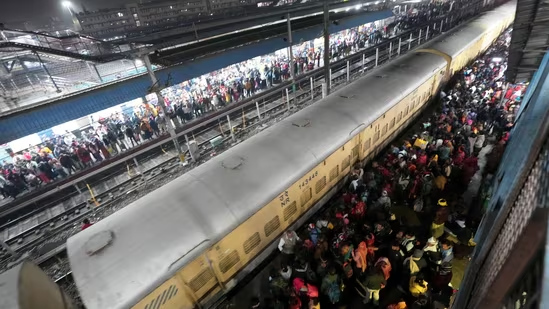

The recent stampede at New Delhi Railway Station has once again highlighted the perils of overcrowding and the need for better crowd control measures. On February 16, 2025, chaos erupted as passengers rushed to board their trains, resulting in a devastating loss of life. This tragedy raises crucial concerns about railway infrastructure, safety protocols, and the necessity for stricter regulations to prevent such incidents in the future.
1. The Incident: How It Unfolded
The stampede took place on the evening of February 16, when hundreds of passengers gathered at New Delhi Railway Station, many traveling to Prayagraj for the Maha Kumbh festival. Due to the massive rush, people started pushing each other to get to their respective platforms. The situation worsened as more passengers entered the station, leading to overcrowding at staircases and entry points.
In the panic, people lost balance and fell over one another, triggering a chain reaction. The sheer pressure of the crowd left many unable to move, breathe, or escape the chaos. The absence of clear instructions and limited space for movement turned the situation deadly, resulting in a tragic loss of lives.
2. Casualties and Immediate Aftermath
The stampede resulted in at least 18 deaths, including five children, and left dozens injured. Many victims were suffocated or crushed under the weight of the crowd. Those who managed to escape the chaos were in shock, and some suffered fractures and serious bruises due to falling on the hard concrete floors.
Emergency response teams arrived at the scene quickly, but the lack of proper access routes and the sheer density of the crowd delayed rescue efforts. Hospitals in the area were overwhelmed as medical teams struggled to provide immediate treatment to the injured. The emotional toll on families searching for their loved ones added to the devastation.
3. Lack of Crowd Control Measures
One of the major reasons for the disaster was the absence of proper crowd control mechanisms. Despite New Delhi Railway Station being one of the busiest in India, there was no systematic plan to regulate the heavy footfall, especially during peak travel seasons like religious festivals. No clear queuing system was in place, and a shortage of security personnel made it impossible to manage the growing rush.
Authorities failed to anticipate the surge of travelers, and the lack of coordination between railway staff and security forces further escalated the chaos. The absence of basic crowd control infrastructure, such as barricades, designated waiting areas, and regulated entry points, directly contributed to the stampede.
4. Government Response and Inquiry
Following the incident, the Indian government launched an inquiry to investigate the cause of the stampede and identify those responsible for mismanagement. The railway ministry has been asked to submit a detailed report on safety lapses, and officials are being questioned regarding their preparedness for handling large crowds.
While authorities have promised improvements, past incidents suggest that such commitments often fade with time. The challenge lies in ensuring long-term implementation of safety measures rather than temporary fixes. The families of victims have demanded justice, and there is growing pressure on the government to take concrete steps to prevent such tragedies in the future.
5. The Role of Infrastructure and Overcrowding
New Delhi Railway Station, despite handling millions of passengers annually, still operates with outdated infrastructure. The station’s narrow platforms, limited staircases, and insufficient waiting areas make it highly vulnerable to overcrowding-related accidents. The increasing demand for train travel, particularly during festivals, further exacerbates the situation.
In contrast, modern railway stations in other countries use advanced crowd management systems, such as automated entry gates, digital monitoring, and designated boarding areas. The lack of such infrastructure in India makes managing large crowds highly challenging, increasing the risk of such disasters.
6. Preventive Measures: Lessons for the Future
To prevent similar incidents, experts suggest implementing advanced crowd management systems, such as CCTV monitoring, controlled entry points, and automated gates. Better coordination between railway staff and security forces can also help in ensuring smoother movement of passengers.
Additionally, raising awareness among passengers about orderly boarding and deboarding procedures is crucial. Strict enforcement of safety guidelines, such as limited platform occupancy, regulated ticketing, and improved signages, can significantly reduce risks. Without immediate action, such tragedies will continue to occur, endangering lives unnecessarily.
Buy Domin and Hosting with our trusted websites
https://www.hostinger.in/
https://www.bluehost.com/
Visit our Website
https://spotself.com/




Leave a Reply